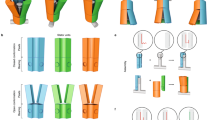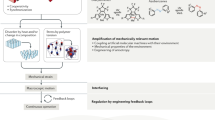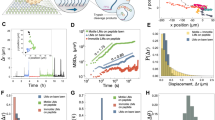Abstract
Some biomolecules are able to generate directional forces by rectifying random thermal motions. This allows these molecular machines to perform mechanical tasks such as intracellular cargo transport or muscle contraction1 in plants and animals. Although some artificial molecular machines have been synthesized2,3,4 and used collectively to perform mechanical tasks5,6,7, so far there have been no direct measurements of mechanical processes at the single-molecule level. Here we report measurements of the mechanical work performed by a synthetic molecule less than 5 nm long. We show that biased Brownian motion of the sub-molecular components in a hydrogen-bonded [2]rotaxane8—a molecular ring threaded onto a molecular axle—can be harnessed to generate significant directional forces. We used the cantilever of an atomic force microscope to apply a mechanical load to the ring during single-molecule pulling–relaxing cycles. The ring was pulled along the axle, away from the thermodynamically favoured binding site, and was then found to travel back to this site against an external load of 30 pN. Using fluctuation theorems, we were able to relate measurements of the work done at the level of individual rotaxane molecules to the free-energy change as previously determined from ensemble measurements. The results show that individual rotaxanes can generate directional forces of similar magnitude to those generated by natural molecular machines.
This is a preview of subscription content, access via your institution
Access options
Subscribe to this journal
Receive 12 print issues and online access
$259.00 per year
only $21.58 per issue
Buy this article
- Purchase on Springer Link
- Instant access to full article PDF
Prices may be subject to local taxes which are calculated during checkout




Similar content being viewed by others
References
Schliwa, M. (ed.) Molecular Motors (Wiley-VCH, 2003).
Kinbara, K. & Aida, T. Toward intelligent molecular machines: directed motions of biological and artificial molecules and assemblies. Chem. Rev. 105, 1377–1400 (2005).
Kay, E. R., Leigh, D. A. & Zerbetto, F. Synthetic molecular motors and mechanical machines. Angew. Chem. Int. Ed. 46, 72–191 (2007).
Browne, W. & Feringa, B. L. Making molecular machines work. Nature Nanotech. 1, 25–35 (2006).
Berná, J. et al. Macroscopic transport by synthetic molecular machines. Nature Mater. 4, 704–710 (2005).
Liu, Y. et al. Linear artificial molecular muscles. J. Am. Chem. Soc. 127, 9745–9759 (2005).
Eelkema, R. et al. Molecular machines: nanomotor rotates microscale objects. Nature 440, 163 (2006).
Kay, E. R. & Leigh, D. A. Hydrogen bond-assembled synthetic molecular motors and machines. Top. Curr. Chem. 262, 133–177 (2005).
Balzani, V. et al. Autonomous artificial nanomotor powered by sunlight. Proc. Natl Acad. Sci. USA 103, 1178–1183 (2006).
Serreli, V., Lee, C-F., Kay, E. R. & Leigh, D. A. A molecular information ratchet. Nature 445, 523–527 (2007).
Panman, M. R. et al. Operation mechanism of a molecular machine revealed using time-resolved vibrational spectroscopy. Science 328, 1255–1258 (2010).
Rijs, A. M. et al. Controlled hydrogen-bond breaking in a rotaxane by discrete solvation. Angew. Chem. Int. Ed. 49, 3896–3900 (2010).
Bustamante, C., Chemla, Y. R., Forde, N. R. & Izhaky, D. Mechanical processes in biochemistry. Annu. Rev. Biochem. 73, 705–748 (2004).
Special issue. Annu. Rev. Biochem. 77, 45–228 (2008).
Evans, E. Probing the relation between force–lifetime–and chemistry in single molecular bonds. Annu. Rev. Biophys. Biomol. Struct. 30, 105–128 (2001).
Liang, J. & Fernández, J. M. Mechanochemistry: one bond at a time. ACS Nano 3, 1628–1645 (2009).
Janke, M. et al. Mechanically interlocked calix[4]arene dimers display reversible bond breakage under force. Nature Nanotech. 4, 225–229 (2009).
Puchner, E. M. & Gaub, H. E. Force and function: probing proteins with AFM-based force spectroscopy. Curr. Opin. Struct. Biol. 19, 605–614 (2009).
Hugel, T. et al. Single-molecule optomechanical cycle. Science 296, 1103–1106 (2002).
Lee, G. et al. Nanospring behaviour of ankyrin repeats. Nature 440, 246–249 (2006).
Brough, B. et al. Evaluation of synthetic linear motor-molecule actuation energetics. Proc. Natl Acad. Sci. USA 103, 8583–8588 (2006).
Altieri, A. et al. Remarkable positional discrimination in bistable light- and heat-switchable hydrogen-bonded molecular shuttles. Angew. Chem. Int. Ed. 42, 2296–2300 (2003).
Rostovtsev, V. V., Green, L. G., Fokin, V. V. & Sharpless, K. B. A stepwise Huisgen cycloaddition process: copper(I)-catalysed regioselective ligation of azides and terminal alkynes. Angew. Chem. Int. Ed. 41, 2596–2599 (2002).
Grandbois, M., Beyer, M., Rief, M., Clausen-Schaumann, H. & Gaub, H. E. How strong is a covalent bond? Science 283, 1727–1730 (1999).
Duwez, A-S. et al. Mechanochemistry: targeted delivery of single molecules. Nature Nanotech. 1, 122–125 (2006).
Hunter, C. A. Quantifying intermolecular interactions: guidelines for the molecular recognition toolbox. Angew. Chem. Int. Ed. 43, 5310–5324 (2004).
Flory, P. J. Statistical Mechanics of Chain Molecules (Hanser, 1989).
Mark, J. E. & Flory, P. J. The configuration of the polyoxyethylene chain. J. Am. Chem. Soc. 87, 1415–1423 (1965).
Crooks, G. E. Entropy production fluctuation theorem and the nonequilibrium work relation for free-energy differences. Phys. Rev. E 60, 2721–2726 (1999).
Liphardt, J., Dumont, S., Smith, S. B., Tinoco Jr, I. & Bustamante, C. Equilibrium information from nonequilibrium measurements in an experimental test of Jarzynski's equality. Science 296, 1832–1835 (2002).
Collin, C. et al. Verification of the Crooks fluctuation theorem and recovery of RNA folding free energies. Nature 437, 231–234 (2005).
Leigh, D. A., Wong, J. K. Y., Dehez, F. & Zerbetto, F. Unidirectional rotation in a mechanically interlocked molecular rotor. Nature 424, 174–179 (2003).
Jarzynski, C. Nonequilibrium equality for free energy differences. Phys. Rev. Lett. 78, 2690–2693 (1997).
Acknowledgements
This research was funded by the Fonds de la Recherche Scientifique-Fonds National pour la Recherche Scientifique (FRS-FRNS; Fonds de la Recherche Fondamentale Collective 2.4.512.07 and Mandat d'Impulsion Scientifique F.4.501.08 to A-S.D.), the Politique Scientifique Fédérale (BELSPO; IUAP VI/27), the European Research Council and the Engineering and Physical Sciences Research Council. C-A.F. is a Research Associate of the FRS-FNRS.
Author information
Authors and Affiliations
Contributions
P.L. and T.S-L. performed the AFM experiments and analysed the data. A.B. carried out the rotaxane synthesis and characterization studies. C-A.F. participated in rotaxane synthesis. A-S.D., C-A.F. and D.A.L. designed the experiments and prepared the manuscript.
Corresponding authors
Ethics declarations
Competing interests
The authors declare no competing financial interests.
Supplementary information
Supplementary information
Supplementary information (PDF 1178 kb)
Rights and permissions
About this article
Cite this article
Lussis, P., Svaldo-Lanero, T., Bertocco, A. et al. A single synthetic small molecule that generates force against a load. Nature Nanotech 6, 553–557 (2011). https://doi.org/10.1038/nnano.2011.132
Received:
Accepted:
Published:
Issue Date:
DOI: https://doi.org/10.1038/nnano.2011.132
This article is cited by
-
Insights from an information thermodynamics analysis of a synthetic molecular motor
Nature Chemistry (2022)
-
The many flavours of mechanochemistry and its plausible conceptual underpinnings
Nature Reviews Chemistry (2021)
-
From molecular to supramolecular electronics
Nature Reviews Materials (2021)
-
Photoinduced directional domain sliding motion in peptide hydrogels promotes ectodermal differentiation of embryonic stem cells
Science China Materials (2020)
-
Conformations and cryo-force spectroscopy of spray-deposited single-strand DNA on gold
Nature Communications (2019)



